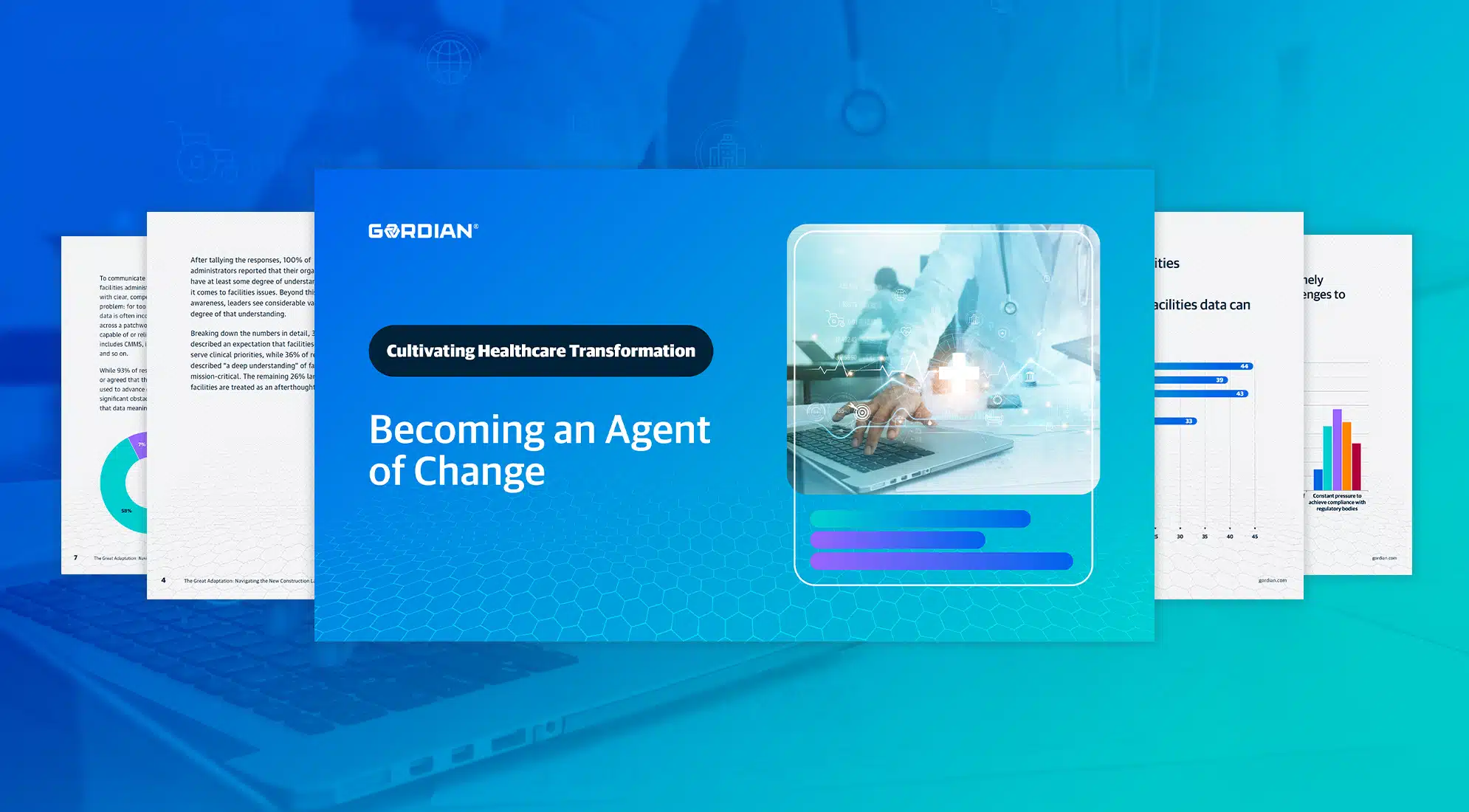In the summer of 2023, Gordian examined the findings of the most recent Report Card for America’s Infrastructure. Published every four years by the American Society of Civil Engineers (ASCE), the report card assigns letter grades to over a dozen categories of U.S. infrastructure, from aviation to wastewater. Overall, American infrastructure earned a C- in 2021, and the ASCE estimated an unfunded needs gap of $2.5 trillion. While that funding gap is so large it stretches into an abstraction, closing it has concrete implications for the country.
The ASCE report card is bigger than an evaluation by a team of engineers; it’s a bellwether for the quality of American life. It highlights areas of need and potential investment that can significantly improve communal assets and the lives of the people who call those communities home. In this blog post, we’ll provide analysis and commentary on the grades the ASCE gave to specific sectors in the hopes of creating a clearer understanding of how U.S. infrastructure can improve. While all sectors are important, for our purposes we will focus on those with the broadest application.
Infrastructure Sector 1: Roads
2021 Grade: D
The road makes us all equals. Regardless of gender, race, religious affiliation or tax bracket, we all depend on roadways to get around. According to the latest infrastructure ASCE report card, that dependence is growing increasingly risky.
The ASCE estimates that 43% of American roads are in poor or mediocre condition. This degradation is no minor inconvenience. It costs individual motorists approximately $1,000 in wasted time and fuel every year and, in total, road deterioration costs all drivers a combined $130 billion in extra vehicle repairs and operating costs annually. On the macroeconomic level, the ASCE found that 72% of the nation’s goods, valued at $17 trillion, are transported via highways and roads. Everyone benefits from well-maintained roads. However, funding has not kept up with capacity.
American motorists traveled a total of 3.9 trillion miles in 2019, the last year of analysis and an increase of nearly 20% since 2000. But the only thing speeding faster than these drivers is the backlog of road repairs, which has reached a total of $435 billion. In 2017, federal and state governments put a dent in the backlog by spending $177 billion on roads and bridges, but the response, while admirable, is wanting.
Infrastructure Sector 2: Water Systems
2021 Drinking Water Grade: C-
2021 Stormwater Grade: D
2021 Wastewater Grade: D+
The movement and treatment of water is essential to maintaining public health and protecting the population from disease. And it’s just downright humane. Unfortunately, when it comes to water infrastructure, American performance is in dire need of improvement.
We begin with drinking water infrastructure, a critical system comprised of 2.2 million miles of pipe. 2.2 million miles, if you were wondering, is upwards of 320 times the distance from New York to Beijing. That’s a lot of pipes. And they get older and more brittle by the second. The ASCE reports that a water main break occurs every two minutes, with estimated losses of 6 billion gallons of treated water every single day.
Funding for water utilities is not adequate to meet demand. The lion’s share of the spending gap rests with the U.S. federal government, which accounted for 63% of capital spending in the water sector in 1977, only for the number to plummet to 9% by 2017.
Water utilities, for their part, are countering the funding gap by increasing operational efficiency and embracing real-time data sensors and other innovations that help them deliver a high-quality product less expensively. Further, they are steeping themselves in asset management tools that aid in risk assessment and project prioritization.
Here’s the good news about U.S. stormwater systems: There are more of them than ever before, as 40 states claim at least one. Now for the bad news: We need more of these systems, as flooding in urban areas grows more common and the amount of impaired water (600,000 miles of rivers and streams and more than 13 million acres of lakes, reservoirs and ponds according to the ASCE) expands. The cost to retrofit existing systems with modern components is exorbitantly high. An $8 billion funding gap to merely comply with current regulations is only making the situation worse.
Lastly, we have wastewater infrastructure, which includes both sewer pipes and 16,000 treatment plants from coast to coast. These treatment centers are stressed. By ASCE’s account, the average wastewater treatment plant functions at 81% of its design capacities, and 15% have reached or exceeded capacity. Utilities spent $3 billion to replace 4,700 miles of sewer pipe in 2019 and are using resilience planning and technology to course correct in the future.
Find out how the Town of Windham, Connecticut upgraded a 50-year-old wastewater treatment facility while avoiding close to $3 million in costs.
Infrastructure Sector 3: Schools
2021 Grade: D+
The schoolhouse is the heart of any community. It’s where children learn, make friends and develop their talents. It’s where citizens come together to exercise their right to vote. It’s where neighbors gather to proudly root their local sports stars to victory. And while public school enrollment is projected to hit 56.8 million students by 2026, there’s not a lot of available data about the conditions of U.S. school facilities. Here’s what we know.
There are approximately 84,000 public schools in America. Around 40% of them reported HVAC issues and 53% of public school districts reported needing to update or replace multiple systems. Yet, the ASCE report card estimates that 40% of schools do not have a long-term facility plan, despite Government Accountability Office estimates that 86% of districts conduct annual facilities assessments. Thus, even if the $38 billion school funding gap closed tomorrow, districts would still need to decide what work to do, in what order and by what means.
See how partnerships can enhance educational facilities management in this free eBook.
Recommendations for Improving Critical Infrastructure
As part of its report card, the ASCE offers suggestions for raising the grades of this critical infrastructure. Synthesis of this advice brings several patterns to the fore and reveals helpful activities that transcend a specific sector. These are solutions that apply universally.
More funding.
America’s purse isn’t big enough to fix all its infrastructure problems. Across the board, the ASCE recommends fundraising via taxes, user fees, grants and appropriations, and finding creative avenues to raise money.
Strategic asset management.
The government agencies, departments and entities charged with maintaining roads and highways, water systems and schools need tools for understanding what they own and how to optimize it. They must regularly assess the conditions of their facilities and other assets, develop savvy budgets to address their needs and put together an informed prioritization schedule. This may require assistance from industry.
Gordian, for instance, offers a suite of condition assessment and facilities capital planning tools organizations use to communicate and prioritize needs and risks, generate long-term strategies and estimate expenses. And they all use our industry standard RSMeans™ Data construction costs. Our technologies provide the data, and our people provide the insight, to help leaders optimize their assets and build better communities.
Emphasize resilience and emergency response.
It’s impossible to divorce the latest ASCE Infrastructure Report Card and climate change. Extended rain and flooding damages roads and overwhelms the stormwater system. Extreme heat and cold can make life miserable for teachers and students in portable classrooms, and public school buildings often double as emergency shelters when disaster strikes. Again, Gordian can help.
Our Job Order Contracting (JOC) solution is an ideal vehicle for doing disaster prep work or quickly completing emergency response projects. That’s because JOC empowers organizations to complete many projects with one contract. This unique, single-solicitation approach reduces construction procurement time by weeks and uses verified, preset prices for incredible cost control. When work needs to be done quickly, done well and done within budget, there’s no better solution than Gordian’s Job Order Contracting.
More Infrastructure Insights to Come
Believe it or not, we’ve only covered a fraction of the categories from ASCE’s Infrastructure Report Card. We’ll be back with more analysis of the ASCE’s findings in future blog posts.






